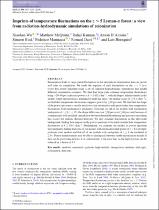| dc.contributor.author | Davé, Romeel | |
| dc.date.accessioned | 2022-11-03T08:36:15Z | |
| dc.date.available | 2022-11-03T08:36:15Z | |
| dc.date.issued | 2019 | |
| dc.identifier.citation | Xiaohan Wu, Matthew McQuinn, Rahul Kannan, Anson D’Aloisio, Simeon Bird, Federico Marinacci, Romeel Davé, Lars Hernquist, Imprints of temperature fluctuations on the z ∼ 5 Lyman-α forest: a view from radiation-hydrodynamic simulations of reionization, Monthly Notices of the Royal Astronomical Society, Volume 490, Issue 3, December 2019, Pages 3177–3195, https://doi.org/10.1093/mnras/stz2807 | en_US |
| dc.identifier.issn | 2331-8422 | |
| dc.identifier.uri | http://hdl.handle.net/10566/8151 | |
| dc.description.abstract | Reionization leads to large spatial fluctuations in the intergalactic temperature that can persist
well after its completion. We study the imprints of such fluctuations on the z ∼ 5 Ly α
forest flux power spectrum using a set of radiation-hydrodynamic simulations that model
different reionization scenarios. We find that large-scale coherent temperature fluctuations
bring ∼20–60 per cent extra power at k ∼ 0.002 s km−1, with the largest enhancements in the
models where reionization is extended or ends the latest. On smaller scales (k 0.1 s km−1),
we find that temperature fluctuations suppress power by 10 per cent. We find that the shape
of the power spectrum is mostly sensitive to the reionization mid-point rather than temperature
fluctuations from reionization’s patchiness. However, for all of our models with reionization
mid-points of z ≤ 8 (z ≤ 12), the shape differences are 20 per cent (40 per cent) because of
a surprisingly well-matched cancellation between thermal broadening and pressure smoothing
that occurs for realistic thermal histories. We also consider fluctuations in the ultraviolet
background, finding their impact on the power spectrum to be much smaller than temperature
fluctuations at k 0.01 s km−1. Furthermore, we compare our models to power spectrum
measurements, finding that none of our models with reionization mid-points of z < 8 is strongly
preferred over another and that all of our models with mid-points of z ≥ 8 are excluded at
2.5σ. Future measurements may be able to distinguish between viable reionization models if
they can be performed at lower k or, alternatively, if the error bars on the high-k power can be
reduced by a factor of 1.5. | en_US |
| dc.language.iso | en_US | en_US |
| dc.publisher | Oxford academic | en_US |
| dc.subject | methods: numerical | en_US |
| dc.subject | galaxies: high-redshift | en_US |
| dc.subject | intergalactic medium | en_US |
| dc.subject | dark ages | en_US |
| dc.subject | reionization | en_US |
| dc.title | Imprints of temperature fluctuations on the z ∼ 5 Lyman-α forest: a view from radiation-hydrodynamic simulations of reionization | en_US |
| dc.type | Article | en_US |

